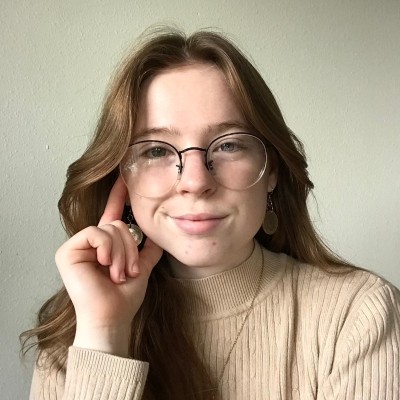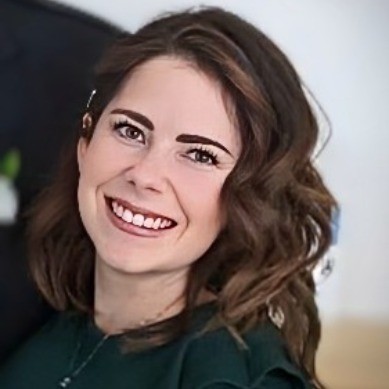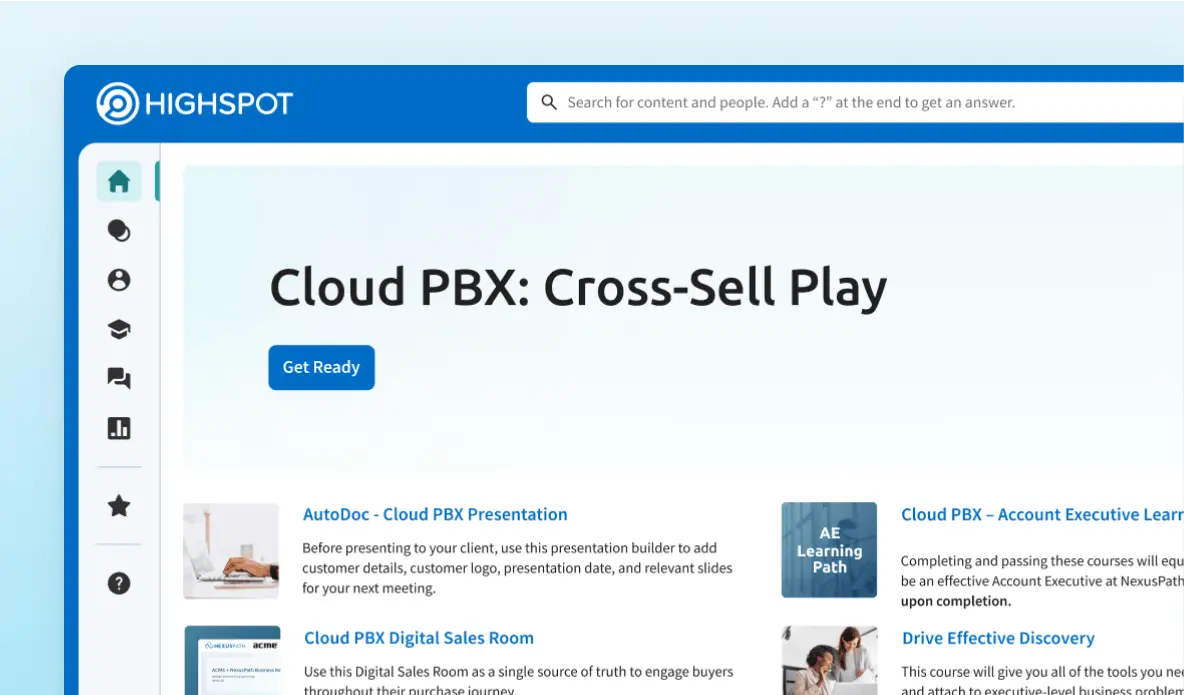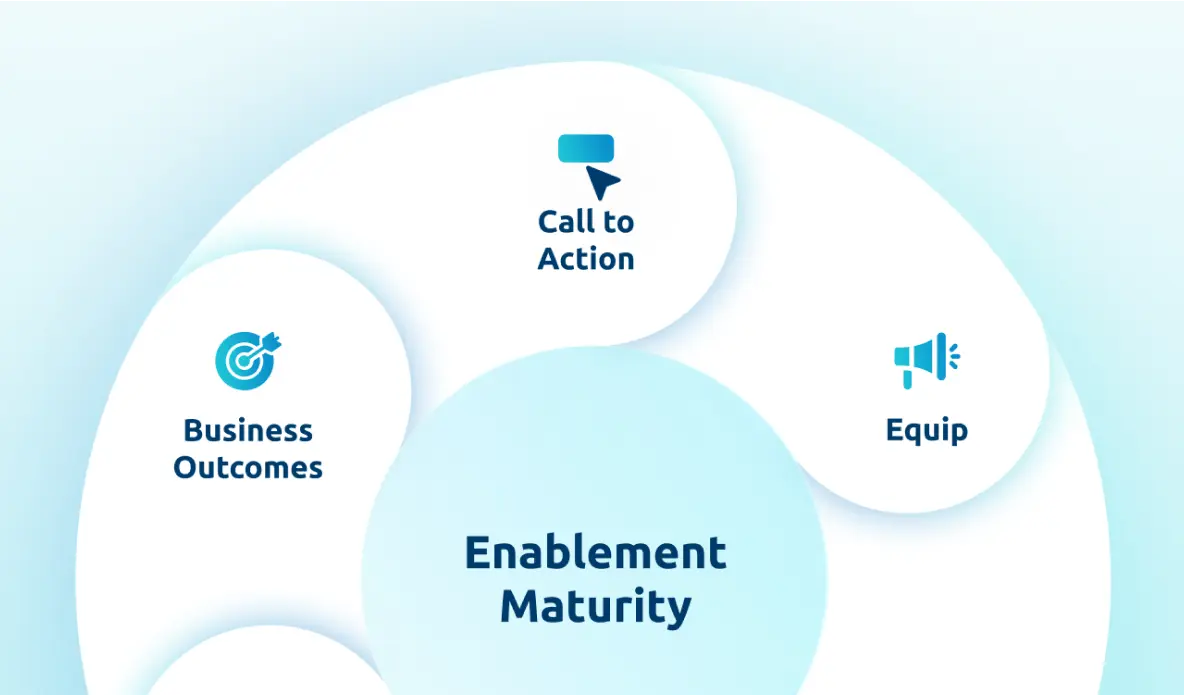According to the State of Sales Enablement Report 2024, 31% of organizations are preparing to launch a new product or service as a key go-to-market initiative. So, how can you prepare your sellers to be ready for a successful product or service launch that drives business results?
Riley Rogers: Hi, and welcome to the Win Win podcast. I’m your host, Riley Rogers. Join us as we dive into changing trends in the workplace and how to navigate them successfully.
Here to discuss this topic is Kate Stringfield, senior manager of revenue enablement at Dialpad. Thank you so much for joining us, Kate. Before we get started, I’d love to learn a little bit more about yourself, your role, and your background.
Kate Stringfield: Yeah, so I’m Kate Stringfield, as you called out. Was in sales prior to being in enablement, and I was in sales for about seven years, both in hospitality as well as SaaS. And then I made the jump into enablement around six years ago, and now I’m over at Dialpad.
RR: Amazing. Thank you for sharing that. I feel like it’s always so helpful to get insight from people who make that transition and have experience on both sides of the playing field.
We’re so excited to have you on the podcast for that reason. You have such extensive experience as both a sales and sales enablement leader. So can you maybe walk us through your journey into enablement, how you made that shift, and then maybe a little bit about how that sales background helps influence your enablement strategy?
KS: Yeah, so I was in hotels, like I mentioned, for a number of years, and I found my passion helping other people as they started out in their new roles and getting them up to speed. And so when I made the move into SaaS, I learned about this cool role called enablement, and I was like, oh my gosh, I gotta—I gotta learn more and get into that.
So since helping others be successful was a—or still is—a passion of mine, I made that jump. And once I landed in an enablement position, I was like, man, I found my place.
So I spent a number of years doing enablement for the sellers that I was once a seller for—like, I was doing that role. And then I did another two and a half years in enablement at an enablement company, where I focused on role-specific enablement, as well as launching a sales methodology, three sales motion changes, and various other initiatives that I supported along the way.
And then I moved over into Dialpad, where I’m now leading a team of six incredibly gifted, talented revenue enablers across sales, success, and partner enablement.
RR: Wonderful. Thank you for walking us through that. It seems like it’s been quite the journey to get where you are today. I’m curious then—we’ve talked about how it informs your strategy—but maybe how does it inform action?
So I kind of want to shift gears a little bit and maybe talk about a recent initiative that I know Dialpad has been running, which is that you rolled out a new SKU after an acquisition, and product launch has become a priority for you this year. So can you maybe talk to us a little bit about that initiative?
KS: Yeah, absolutely. So making sure that our product is up to speed and ahead of the market is imperative. And so, gosh, around eight months ago, back in October, we acquired a WFM company—so workforce management—which is part of a solution of ours that we did not currently have. So we acquired a company in order to offer that as a complementary solution with what we already had.
This was a completely new product line, and we had to figure out, okay, how could we enable our reps to be able to go ahead and sell this? And it’s a slightly different selling motion, so we had to talk through what is it, why does it matter, as well as how do they then position the value of it. And so in true SaaS fashion, we were also, in addition to launching this new SKU, we also had other product enhancements that we were sharing along the same time, as well as a rebranding and new marketing strategy and a new pitch deck.
So there was a lot going on. So we had to make sure that we also landed this and landed it well. And so we did some pre-launch awareness where we equipped our sellers with content in the form of kits as well as micro-learnings and giving them the foundation to get them ready for that launch moment so they could start having introductory conversations with customers.
So how do you first scope that? Then we did our launch moment and made our just-in-time much more robust and turned them into true sales plays where they learned how to really position this product in the right way and along the whole sales process. And with that, we also did additional learning moments, such as full-blown e-learnings and certifications for how to sell this.
Then we really wanted to focus on reinforcement that stuck, and so we looked at, okay, how can we get our managers speaking about this product in team meetings? What kind of activities could we give to managers to run in team meetings, such as trainings in a box? And how can we continue to evolve the conversation and get our reps learning more?
And so we focused on PEC talk as well as more thorough, in-depth enablement from a product standpoint, and then that later along the line sales motion and how to sell that. And overall, we saw around $500,000 of closed-won sales initially, and we built around $3 million in pipeline. And through that, we also looked at data with the kit and with the play that—you know, the kit that shifted into the play—and a lot of our reps were using it. There was high adoption of it. They were going back to it multiple times and spending about four minutes consuming the content.
And so we were able to track, alright, they did the enablement, they were using the content and sharing it with customers, and then that translated to those closed-won numbers and that pipeline build that I discussed.
RR: That sounds like such a thoughtful approach and also like quite a lot of work. I’m sure that was quite difficult to execute, but I love that you’re already seeing the results that you’re looking for. I’d like to maybe dig a little bit more into kind of the initial concept phases where you’re staring down the barrel of this initiative.
What kind of challenges do you see reps tending to face when it comes to things like product launch, and what were your best practices for overcoming them as you were executing over the next few months?
KS: Yeah, information overload is a big one. And it’s one that—you know, I mentioned we did this in conjunction with other product enhancements and a marketing branding shift in our messaging, as well as a pitch deck launch.
So you know, besides that, reps are always being overloaded with information, and so that’s always something you have to contend with as a challenge. Also, when reps are learning about how to sell a new product, it’s something that’s outside of their existing knowledge and skill set a lot of the time or, you know, is just stretching them in a different way.
And so you have to figure out how to use the foundation that they already had and build upon that. And then sometimes there’s additional complexities as well. And so when I think about those challenges and how to solve for them, I think about, you know, making sure that you’re taking a crawl-walk-run approach with those product launch moments and building upon what they already have to get them into that run state, but not expecting them to run right out of the gate—which a lot of times is an expectation that happens.
So making sure that we’re setting them up for success in learning and building upon that learning, and then also creating resources that really meet them where they are in their tenure and their journey, and being able to translate complex information into simple information that they can digest, consume, put into practice, and then go and evangelize. And then also weaving in sales subject matter experts that really know how to sell your current product and what talking to your customers is like currently, and using them as subject matter experts to really inform that sales motion of that product launch.
RR: Great. I think those are all wonderful strategies. And I know kind of a common one when it comes to product launch that you need to keep in mind is just how crucial cross-functional alignment is for the success of a launch. So can you talk to me a little bit about how you create and maybe maintain alignment as you’re building and executing your launch enablement strategy?
KS: Yeah, it is so critical. And communication in general in all relationships is so important. And so this is one that really is the make-or-break fail point in a lot of companies. And so having regular touchpoints with subject matter experts across various teams such as—you know, as I called out, sales and success—but also product marketing and other marketing teams. Operations is another really key one.
There are so many different teams, and if you’re lucky, you’ll have a business transformation team or a project management team that’s there to foster all of those cross-functional relationships and create that alignment.
We work really closely with our product managers and our product teams. We meet with them regularly within our enablement role. In fact, we have somebody in enablement at Dialpad that’s focused on our product and pricing strategy, and so he has these deep relationships with these different teams and different individuals across the business.
Additionally, we have a product launch playbook that we have socialized with these cross-functional partners so they know what that playbook looks like, how it can act modularly, and where they play in the process of the playbook—or where they fit into the process, so to speak.
And so that really helps us create that alignment and speak the same language. Lastly, we focus on retrospectives—so making sure that we’re learning from each product launch or product release to the next, and by performing retrospectives and having that discussion over, hey, what worked really well, what maybe didn’t work as well, and what can we make better the next time?
RR: I love those strategies. I think the Product Launch Playbook is such a clever idea to kind of get everybody on board and aligned with what you’re expected to accomplish. I also love the idea of coming back and reviewing. Sometimes the business runs so fast that you feel like you can’t, but that moment is just as essential—almost—as that next product launch. So I love to hear that.
Thinking then of how you’re launching, I’d also like to know a little bit about once you’ve established alignment, how you’re then developing that launch strategy to start running with. Could you talk me through the components of your launch strategy and then maybe how you’re partnering with an enablement platform to support and scale it?
KS: Yeah, so that Product Launch Playbook is key. And making sure that it’s modular and nimble to work with various forms or shapes and sizes in which products or, you know, product launch moments happen.
Highspot is truly the home—or I guess any platform that people might use—to host just-in-time resources. For us, it’s Highspot, and it truly is the home and where we expect reps to go to first. And so if we think about it in that way, we need to build around that concept. So having that host pre-launch and post-launch and launch materials, having it give guidelines on how to execute—whether it is, you know, as an SDR, BDR, ADR, picking up the phone, what to say, how sellers should be selling the product, how our Customer Success Managers should be reviewing adoption for the product—all needs to live there.
We also focus on asynchronous learning, so making sure that we’re not pulling reps out of prime-time selling and giving them space and time to learn on their own, but also checking their knowledge through knowledge checks and certifications. And then all of this new information happening during a product launch needs to, in some way, shape, or form, be folded into onboarding.
So thinking about how that comes back into onboarding so that reps who start tomorrow can benefit from that information and be able to hit the ground running.
RR: Yeah, there are a lot of different lenses to look at it and areas in which it needs to be embedded, so that all makes sense. On the note of enablement platforms, I know that Dialpad had previously partnered with another enablement solution, so can you maybe share why Highspot was the better fit for your organization as well as how it supports your enablement strategy today?
KS: Yeah, Highspot is integral.
It’s integral in that it is where our reps start their day and where they end their day. It hosts all of our content, both internal-facing and external-facing. So Highspot is a game changer for us because within my team it’s easy for us to manage from an admin perspective and to practice governance across the various teams that are content creators or host content and manage it there.
Our reps are familiar with using it. That’s another thing—you know, having a solution like Highspot is something that reps come to expect nowadays, and so they’re familiar with it, they know how to use it, and we’re constantly thinking about how they interact with it and how we can train them to interact with it better.
Our Highspot team—so the team that helps us at Highspot—is a differentiator. So that is our CSM and our AM. So Jess, Emily, our Technical Account Manager Brian, and Matt Hunin, our Solutions Engineer, all help us be able to learn the latest and greatest, utilize what we already have, and maximize our value.
And then potentially look at other things that might help us as we overall, as a company, shift to more of a just-in-time strategy. So moving away from live sessions that people are going to forget most of what you said, moving away from, you know, long e-learnings, and more of, okay, I’m in—you know, I have to prepare for this call in 15 minutes—where am I going to find that information?
Surfacing it up in Highspot and making it easy to find has become a game changer in helping them—meeting them where they’re at and giving them the information they need to be successful.
And then we can use data from Highspot and correlate that to leading indicators on whether reps are doing the kind of behaviors we want to see and how that ties to business outcomes. And are the reps actually closing deals or protecting revenue as a result?
RR: Well, that’s all great to hear, and I always love to hear a really positive experience. I’m so glad that your account team is there to support you through all of it.
We have heard through the grapevine, actually, that you’re doing some really awesome work with the platform, and one area where you’ve seen a lot of success is actually through Digital Rooms—with over 342 Digital Rooms created in Highspot, as well as a 9% increase in external engagement, which is wonderful just to call that out.
So what are some of your best practices for driving that adoption?
KS: Yeah, yeah. We moved to Digital Rooms just last year, if you can believe it, from pitch templates. And one of the things we did first off was—there was a Highspot University course around Digital Rooms that we took, and we also used materials that we were able to find from Highspot so we could become proficient ourselves as the people that were enabling the reps.
We then built a dedicated Digital Room kit to help reps get familiar with the why and the how of Digital Rooms and provided them with walkthroughs. And then we hosted sessions, we did asynchronous learning, we do one-on-one support for our reps on why it’s important, how to build, how to find engagement and analytics.
And we regularly also work with reps to get feedback—so figure out what’s working, how do we build templates that make it really easy for them to add in what they want to add in, what information do they always add in so we can just add it into the template for them.
Another thing that we thought about was—we use Consensus for demo videos, and so integrating Consensus into there, and how do we make that easy?
We have also thought about Digital Rooms not just for sales. We’ve thought about it for our sales development reps and what are their use cases, and built templates for them, and done specific training for them, and gotten feedback from them.
We’ve also thought about the post-sales journey a lot. So how do we get our client sales reps using it to position cross-sell and upsell? And then customer success—where do we feed in content for QBRs or other conversations that they’re having with customers and integrating in their feedback to make their templates better?
So we’re always thinking about how to get our reps more and more proficient and making that a focal point month over month. And we’re really excited for some of the enhancements coming to Digital Rooms that we’re going to capitalize on moving forward and making sure our reps know how to use it.
RR: Yeah. I love that you led with educating yourself first, because how can you enable on something that you haven’t been in those weeds with as well?
Well, that’s one of the biggest things you can give your reps—is to build with them in mind. You know their work, you can build something for them, and then actually they’ll use it. It sounds simple, but it’s really hard to do.
So I’d love to hear a little bit of a shift in focus, but I’m curious if you could walk me through how you measure the impact of—and maybe then begin to optimize—some of your enablement efforts?
KS: Yeah, I think about measuring impact of enablement in three ways. So you have the first prong, which is your enablement effort in general. So how do you measure enablement through, like, what activities are you doing?
So this is—you know, if you think about the Kirkpatrick model—this is Level 1 and Level 2: Was your training effective? Were you able to certify, you know, X number of reps? That sort of thing. Those are examples of that.
Then I think about the second prong, which is leading indicators. And this is about behavior. Are the reps able to take what they have learned and apply it to their daily workflow? Maybe it looks like building pipeline, maybe it looks like having certain conversations with customers or sending information to customers. You know, it could be various things that are that kind of Level 3 of Kirkpatrick.
And then the third prong is at Level 4—so thinking about those business outcomes that are the goals of why you are doing this whole enablement approach to begin with. What kind of revenue are you trying to impact? Are you trying to impact conversion rates, you know, average deal size? Are you trying to increase revenue? Are you trying to protect revenue—so reduce churn and downsell?
Those are all things that, you know, are on my mind. And then the correlation between the three—the correlation between the enablement efforts, the behavior change that you’re seeing through leading indicators, and the business outcomes.
And so when it comes to then, okay, we’ve launched something, we’ve measured it, and now we’re trying to optimize it—it is then looking at, alright, what are the different checkpoints along the way in which we can say, did we do our job? Or do we need to go back and do more?
And so maybe it looks like, hey, are they actually reviewing the play or the kits? Are they sending the content to customers? If not, why? We can ask those questions, because we can see the data on whether or not they’re doing it. Are they saying it in customer conversations? That looks like utilizing a conversational intelligence tool to see if they’re actually using it in those conversations.
We can start to dig into all the different pieces and figure out where we need to refine our enablement approach to fill that gap.
And so we can utilize Highspot to do that, our data in Salesforce to do that, conversational intelligence data. There are many different ways, but just having that data to dig into it, and then asking questions to reps is so important.
RR: Thanks so much for that really thoughtful step-by-step walkthrough. I think that’s really actionable, and I think our listeners will take a lot away from it. I know that measurement is always going to kind of be difficult for enablement teams, so I love just hearing how folks have developed real actionable strategies for making it happen.
But on the subject of measurement, I’d love to know—since implementing Highspot, what business results have you achieved? Any wins that you could share or just anything that you’re proud of that you’ve accomplished over at Dialpad?
KS: Yeah, I’m proud of so much. Our team has done a phenomenal job, and as you called out—you know, the successes with Digital Rooms and that new product that we launched, that new SKU—those are really huge.
Additionally, we have utilized Highspot to realize over $16 million of influenced revenue in just 2024 alone within our revenue organization. That is such a testament to how much our reps have Highspot integrated into their day-to-day life, and then how they use that information to speak to customers, how they use their messaging, and then how that behavior results in those closed-won opportunities.
Additionally, partner is such a huge focus of Dialpad—so our partnerships with our resellers, our partnership with our channel—and we have seen a high increase: 23% of our partner material being used and being viewed and then being leveraged, which is also something I’m very proud of.
And then the project that I’m currently working on that I’m proud of—but, you know, time will tell on results—is I’m working on a robust governance strategy so we can really take Highspot to the next level and make our cross-functional partners more of the partners in how the content gets delivered to our reps.
And so I’m really looking forward to rolling out our more robust governance strategy this year.
RR: We’ll stay tuned on how it goes. I mean, those are already incredible results, so thank you so much for sharing.
Just one last question for you before we close out—would love for you to share maybe what the biggest pieces of advice you’d give other enablement leaders to help them drive a successful product launch.
KS: I think the modular Product Launch Playbook has been huge—so having a laid-out plan for how you would run a product launch from start to finish in enablement and making sure that it fits all sizes, shapes, and formations of what a product launch might look like.
And then the other piece of advice I would give is having regular communication and good working relationships across multiple cross-functional partners so that siloed work becomes less of a thing you have to battle. Because that just means that, you know, working together, we all lift each other up.
And so that’s something that then trickles down to our reps, but then also trickles out to our customers and makes them more willing to buy from us. So I think cross-functional relationships are just so key—and so keep on working on those relationships.
RR: Those are both fantastic pieces of advice, so thank you for taking the time to come share these insights with us. I think I speak for myself and our listeners when I say that I learned a lot of valuable information and was taking notes for sure.
To our audience, thank you so much for listening to this episode of the Win-Win podcast. Be sure to tune in next time for more insights on how you can maximize enablement success with Highspot.




